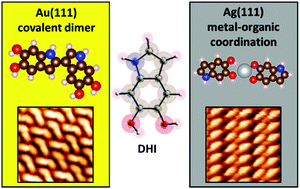Room-temperature surface-assisted reactivity of a melanin precursor: silver metal–organic coordination versus covalent dimerization on gold†
Abstract
The ability of catecholamines to undergo oxidative self-polymerization provides an attractive route for preparation of coatings for biotechnology and biomedicine applications. However, efforts toward developing a complete understanding of the mechanism that underpins polymerization have been hindered by the multiple catechol crosslinking reaction pathways that occur during the reaction. Scanning tunneling microscopy allows the investigation of small molecules in a reduced-complexity environment, providing important insight into how the intermolecular forces drive the formation of supramolecular assemblies in a controlled setting. Capitalizing on this approach, we studied the self-assembly of 5,6-dihydroxy-indole (DHI) on Au(111) and Ag(111) to investigate the interactions that affect the two-dimensional growth mechanism and to elucidate the behavior of the catechol group on these two surfaces. X-ray photoelectron spectroscopy, together with density functional theory and Monte Carlo modeling, helps unravel the differences between the two systems. The molecules form large ordered domains, yet with completely different architectures. Our data reveal that some of the DHI molecules deposited on Ag are in a modified redox state, with their catechol group oxidized into quinone. On Ag(111), the molecules are deposited in long-range lamellar patterns stabilized by metal–organic coordination, while covalent dimer pairs are observed on Au(111). We also show that the oxidation susceptibility is affected by the substrate, with the DHI/Au remaining inert even after being exposed to O2 gas.



 Please wait while we load your content...
Please wait while we load your content...
